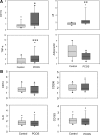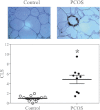PCOS is associated with increased CD11c expression and crown-like structures in adipose tissue and increased central abdominal fat depots independent of obesity
- PMID: 23118428
- PMCID: PMC3537096
- DOI: 10.1210/jc.2012-2697
PCOS is associated with increased CD11c expression and crown-like structures in adipose tissue and increased central abdominal fat depots independent of obesity
Abstract
Context: Adipose tissue macrophage (ATM) infiltration is a major pathway for obesity-induced insulin resistance but has not been studied as a mechanism for insulin resistance in PCOS.
Objective: We tested whether polycystic ovary syndrome (PCOS) is associated with increased ATM infiltration, especially of inflammatory subtype identified by the CD11c marker.
Design and setting: We conducted a case-control study at an academic medical center in the United States.
Participants and interventions: Fourteen PCOS and 14 control women of similar age and body mass index (BMI) underwent a gluteal fat biopsy. Markers of ATM, integrins, TNF-α, and adiponectin, were analyzed by quantitative RT-PCR using a standard curve method. Crown-like structures (CLS) were identified by immunohistochemistry. Abdominal magnetic resonance imaging and frequently sampled i.v. glucose tolerance test were performed to assess abdominal fat and insulin sensitivity (SI).
Main outcome: Women with PCOS were compared with control women of similar age and BMI for ATM markers, CLS density, adipose tissue expression of inflammatory cytokines and adiponectin, SI, and abdominal fat depots.
Results: Women with PCOS had an increase in CD11c expression (P = 0.03), CLS density (P = 0.001), α5 expression (P = 0.009), borderline increase in TNF-α expression (P = 0.08), and a decrease in adiponectin expression (P = 0.02) in gluteal adipose tissue. Visceral (P = 0.009) and sc abdominal fat (P = 0.005) were increased in PCOS. SI was lower in PCOS (P = 0.008).
Conclusions: PCOS is associated with an increase in CD11c expression and CLS density and a decrease in adiponectin expression in sc adipose tissue. Additionally, PCOS is associated with higher central abdominal fat depots independent of BMI. These alterations are present among mostly nonobese women and could represent mechanisms for insulin resistance.
Figures


References
-
- Sam S, Dunaif A. 2003. Polycystic ovary syndrome: syndrome XX? Trends Endocrinol Metab 14:365–370 - PubMed
-
- Diamanti-Kandarakis E. 2006. Insulin resistance in PCOS. Endocrine 30:13–17 - PubMed
-
- Dunaif A, Segal KR, Futterweit W, Dobrjansky A. 1989. Profound peripheral insulin resistance, independent of obesity, in polycystic ovary syndrome. Diabetes 38:1165–1174 - PubMed
-
- Dunaif A, Segal KR, Shelley DR, Green G, Dobrjansky A, Licholai T. 1992. Evidence for distinctive and intrinsic defects in insulin action in polycystic ovary syndrome. Diabetes 41:1257–1266 - PubMed
-
- Olefsky JM, Glass CK. 2010. Macrophages, inflammation, and insulin resistance. Annu Rev Physiol 72:219–246 - PubMed
Publication types
MeSH terms
Substances
Grants and funding
LinkOut - more resources
Full Text Sources
Other Literature Sources
Medical
Research Materials
Miscellaneous

